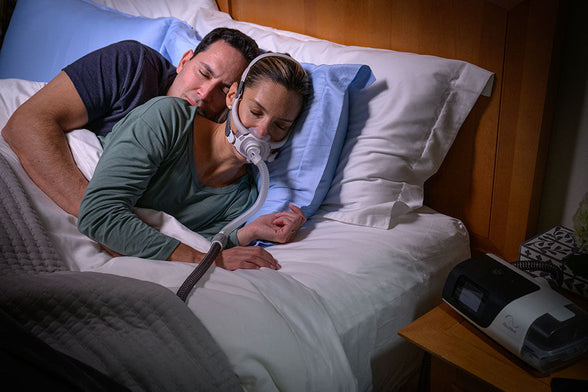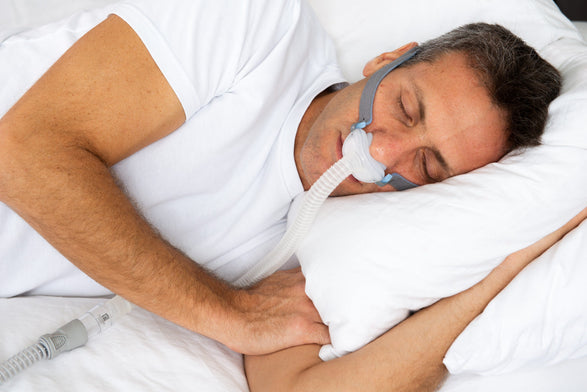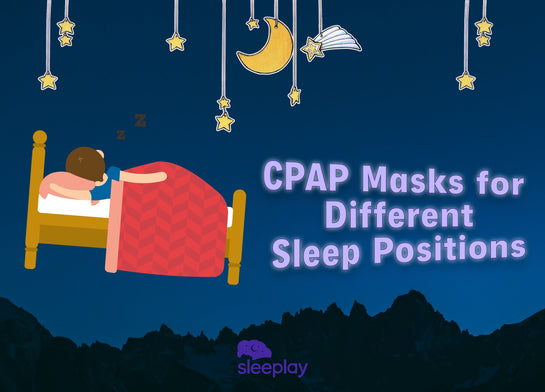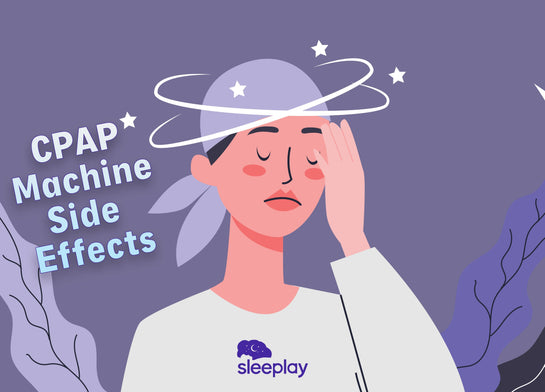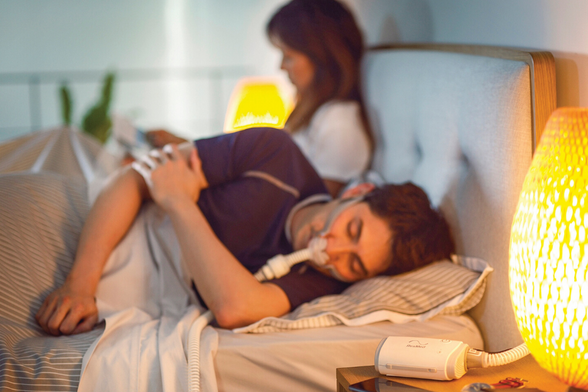Is CPAP-Related Aerophagia Dangerous?
Sleep apnea is one of the most common sleep disorders and also a serious health condition. It occurs when breathing stops and starts again multiple times at night, decreasing oxygen levels to important organs and interrupting sleep. Fortunately, Continuous positive airway pressure (CPAP) therapy has proven to be an effective treatment.
CPAP machines provide consistent air pressure that keeps your upper airway open during sleep. However, this device can cause you to swallow too much air while using it, resulting in uncomfortable symptoms.
This article will explain why this happens and how to control it with lifestyle and CPAP modifications.
What is Aerophagia?
Aerophagia refers to the unintentional act of swallowing an excessive amount of air, leading to excess gas in the gastrointestinal system, especially in the stomach. This gas can accumulate, causing bloating and other gastrointestinal symptoms.
Ingesting a small amount of air while eating or talking is common and happens daily. Some are burped, and the rest pass through the intestinal system and out as flatulence. Most people don’t have problems expelling that gas, but in aerophagia, the extensive quantity makes it difficult to eliminate.
It can happen quickly, being acute, but it can also turn into a chronic condition. Even though CPAP-related aerophagia has been the subject of recent studies, any person can experience aerophagia at a given moment.

How Does CPAP Therapy Cause Aerophagia?
CPAP machines deliver a constant stream of pressurized air to the upper respiratory airway to keep it open. Many healthcare providers consider them one of the most effective treatments for sleep apnea, but some side effects, such as aerophagia, may arise while using them.
There are many causes why CPAP users may sallow air while using the device, resulting in symptoms of aerophagia. This sleep apnea treatment can lead to the swallowing of air due to:
Inadequate Air Pressure Levels
If the pressure settings are too high, the air delivery can increase, causing the person to swallow excess air. Low-pressure settings might as well cause you to swallow air. In this case, due to the effort to swallow more air.
Inadequate use of CPAP Ramp setting
The ramp setting in some CPAP machines can cause aerophagia if this feature is not adjusted correctly.
Mouth Breathing
Mouth breathing during CPAP therapy can cause the loss of pressurized air. This results in your body taking extra breaths, inspiring air that will not be inhaled but swallowed. This is very common because many patients with sleep apnea breathe through their mouths to compensate for poor nasal breathing.
Difficulty Breathing Out During CPAP Treatment
In CPAP treatment, the pressurized air stream remains the same for inhalation and exhalation, but some people may experience trouble coordinating both processes if they use mid- to high-pressure settings. This can result in breathing inconsistencies that produce aerophagia.
Nasal Congestion
Patients with nasal congestion due to allergies or colds tend to breathe through their mouths, and this also happens to people with a deviated septum.
CPAP Mask Leaks
Wearing an inadequate CPAP mask may produce air leaks because the person will open their mouth to compensate, therefore swallowing air.
Sleeping Position
Back sleepers have more chances of swallowing air, especially if their mouth is open.

Is CPAP-related Aerophagia Dangerous?
Aerophagia, or air swallowing, is a common side effect of continuous positive airway pressure (CPAP) therapy. It usually leads to a buildup of gas in the gastrointestinal system. CPAP-related aerophagia is usually not dangerous, but its symptoms can be quite bothersome, especially if they last for a long time.
Many causes of aerophagia are associated with physical or physiological causes and related to common day-to-day activities, such as chewing gum, hyperventilating, drinking carbonated beverages, breathing in through your mouth while exercising, and smoking cigarettes.
Symptoms of Aerophagia as a Side Effect of CPAP Machines
Even though some aerophagia can be normal while using a CPAP device, sometimes the amount of air swallowed becomes excessive, causing unpleasant symptoms depending on where most of the air is lodged.
Aerophagia related to CPAP therapy has been the object of many studies . Some of the most common symptoms are:
Bloating
Bloating is a subjective feeling of fullness or swelling in the abdominal region, usually resulting from accumulating gas in the intestines, overeating, constipation, or lactose intolerance.
Increased belching or flatulence
These symptoms are directly related to air buildup. Belching is the release of air or gas from the stomach or esophagus through the mouth. When gas is expelled via the anal passage as a result of air inhalation or the breakdown of food by bacteria in the large intestine, flatulence occurs.
Increased satiety
Early satiety is a medical term for the feeling of fullness after eating just a few bites of food or even before finishing a normal-sized meal, which may be accompanied by nausea.
Abdominal discomfort or pain
Air accumulation can also lead to abdominal pain, which can be characterized as cramping, dullness, or aching and may be associated with one or more of the symptoms described above
Heartburn and acid reflux
Heartburn is a burning sensation in the stomach and is sometimes associated with the eructation of acid fluid. Researchers think the swallowed air pushes the stomach upwards, causing its acid to reach the esophagus.
How To Treat and Prevent Aerophagia During CPAP Treatment
Air swallowing can be prevented and treated by changing your CPAP treatment and lifestyle. In some cases, patients may also require anti-gas medications to manage their symptoms.
1. Using The Ramp Feature
The CPAP ramp allows the user to increase the air pressure incrementally every five minutes over 45 minutes. If your CPAP machine has this feature, you can work with your health specialist to determine an adequate setting, remembering that it can also promote aerophagia if not well adjusted.
Many devices provide different ramp settings to meet the needs of different CPAP users. One such device is the ResMed AirSense™ 11 AutoSet™ CPAP Machine, which has an Auto Ramp function that starts with a low airflow pressure to help you fall asleep and gradually raises to the level you specify.
2. Using The Expiratory Pressure Relief Feature
The expiratory pressure relief feature reduces air pressure automatically upon exhalation. It has a different name depending on the machine (BIFLEX, AFLEX) and needs to be set up manually, so it’s important to learn how to use it.
In addition to the CPAP device described above, the AirSense 10 CPAP Machine also has this expiratory pressure relief feature.
3. Try a Different Type of CPAP Mask
There is evidence supporting the use of nasal masks to swallow less air, not only because of the mask design but also because wearing a chin strap keeps the mouth closed. However, not everyone benefits from using the same type of masks.
It’s always important to talk with your doctor to find the most adequate mask for you because this decision depends on many factors, such as your sleep position . If you use a full-face mask, you should practice fitting it properly so it forms a tight seal on your face.
4. Switch to an Auto-adjusting CPAP Machine or a BiPAP Machine
There are many types of CPAP machines , and you need to choose the right one for you. In the case of Auto CPAP and BiPAP devices, they have been proven to reduce aerophagia because of their special air delivery system.
•Auto-adjusting positive airway pressure ( APAP ) device: Studies have found this device to cause less aerophagia than a CPAP. An APAP machine has built-in sensors that monitor the user's breathing and modify the air pressure level accordingly. This capacity to adjust the pressure settings makes it possible to decrease the average pressure overnight and limit aerophagia.
•Bilevel positive airway pressure machines: These devices, also known as BiPAP machines, have a bilevel delivery system that causes the user to have less air during exhalation, helping relieve aerophagia symptoms. For example, The ResMed AirCurve 10 is one of the best BiPAP devices available on the market. It uses a technology that mimics the normal breathing waveform to treat your sleep apnea with minimal discomfort.
5. Change Your Sleeping Position
Sleeping on your side instead of your back may help decrease aerophagia, and it’s also considered to reduce the airway blockages that characterize obstructive sleep apnea
6. Reducing CPAP Pressure Levels
It’s important to remember that a healthcare specialist must adjust pressure levels if necessary. If a wrong fitting is made, the CPAP machine will not treat sleep apnea correctly.
7. Use Over-The-Counter Anti-gas Medication
Several brands of over-the-counter medications reduce aerophagia symptoms, but talking with a health professional will give insight and specific guidance. These medications are usually taken before going to sleep but have not been proven to relieve gas-related symptoms.
8. Lifestyle changes
Although changes in your CPAP therapy can improve the symptoms, life modifications are key and must be taken into consideration when undergoing aerophagia treatment.
•Make Changes to Your Diet: Your dietary habits affect how much gas the gastrointestinal system produces. Avoiding or decreasing vegetables like turnips and cabbage, dairy products, and certain artificial sweeteners is recommended since they can trigger excess gas.
•Stop Smoking: Smoking tobacco or using vaping increases air swallowing, so reducing or quitting smoking may help decrease excess intestinal gas, along with all the other health benefits of quitting smoking.
•Avoid Chewing Gum: Chewing gum has been associated with an increased amount of swallowed air because you also swallow air. For this reason, it’s suggested to avoid gum, other chewy foods, and candy.
•Avoid Using a Straw: Straws can pull air up along the beverage and also make you drink faster than you should.
•Avoid carbonated beverages: These beverages contain carbon dioxide, a major component of air, so drinking them is similar to taking a big breath. Therefore, limiting their consumption may help control aerophagia symptoms.
•Avoid some alcoholic beverages: Even when beer and sparkling wine are not carbonated beverages, they have also been associated with aerophagia.
•Eat slowly and with your mouth closed: It’s recommended that you eat and drink slowly, waiting a few seconds between each bite and chewing it completely before swallowing it.
Other recommendations regarding the psychological causes of aerophagia include learning techniques that help you breathe slowly and deeply if you hyperventilate when nervous. For example, breathing from the diaphragm gives you more control over the duration and size of the breath. If you suffer from anxiety, it’s also suggested that you consult a health specialist.
When to Consult with a Healthcare Provider ?
Even though aerophagia is a common and usually harmless side effect of using a CPAP machine, it’s important to consult a doctor if you experience severe bloating, burping, or flatulence, along with any of the following symptoms:
•Chest pressure or pain
•Bloody stools
•Vomiting or diarrhea
•Weight loss
•Worsening heartburn
•Severe abdominal pain
Even though recent studies have led to explanations regarding its cause, symptoms, and treatment, many questions still have yet to be answered about related CPAP-induced aerophagia.
There are specific CPAP therapy-related recommendations you can follow to decrease aerophagia symptoms, but these always need to go along with lifestyle changes that will ultimately lead to major improvements.
It’s important to consult your doctor if these symptoms are persistent and keep getting worse to either get guidance on anti-gas medication, modify your CPAP therapy parameters, or rule out other gastrointestinal tract conditions.
Meanwhile, at Sleeplay , we have everything you need to make your CPAP journey a more pleasant experience.
Join the conversation!, login and comment.
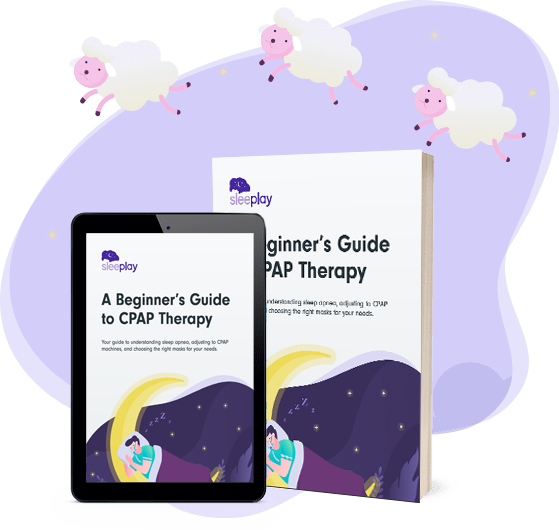
Get your guide to understanding sleep apnea, adjusting to CPAP machines, and choosing the right masks for your needs.




